Effective process management is essential for organizations striving to enhance efficiency and drive growth. By systematically analyzing and optimizing workflows, businesses can eliminate bottlenecks, reduce costs, and improve overall productivity.
If you’re ready to transform your business operations for the better, read on.
In this guide, you’ll discover the importance of process management, how to apply it in various contexts, and how to optimize your approach using essential strategies and tools like monday work management.
Get startedWhat is process management?
Process management — often known as business process management (BPM) — is a systematic approach that focuses on designing, implementing, monitoring, and optimizing business processes to achieve specific organizational goals. It not only helps organizations streamline their operations but also aligns them with strategic objectives while enabling them to adapt to changing market conditions effectively.
Process management:
- Saves resources by minimizing waste and maximizing output
- Guides employees on how to perform tasks effectively
- Fosters teamwork by ensuring everyone understands their roles within processes
Why is process management important?
Process management is essential for enhancing operational efficiency, reducing costs, improving quality, and ensuring customer satisfaction. Implementing robust process management practices is crucial to the long-term success of any organization.
1. Increased efficiency and productivity
Effective process management streamlines operations by identifying and eliminating inefficiencies, redundancies, and bottlenecks within workflows. This leads to significant time savings and improved productivity as employees can focus on value-added activities rather than repetitive tasks. By automating processes and optimizing workflows, organizations can enhance their overall operational efficiency.
2. Reduced costs
By systematically managing processes, organizations can reduce operational costs. Process management helps identify areas where resources are wasted or misallocated, allowing for better utilization of assets and personnel. Over time, this leads to substantial cost savings without compromising quality.
3. Improved quality control
With well-defined processes in place, organizations can ensure consistent quality in their products and services. Process management facilitates standardization, which minimizes errors and improves outcomes. This consistency is crucial for maintaining customer satisfaction and promoting a culture of continuous improvement.
4. Enhanced customer satisfaction
Process management aligns business processes with customer needs, ensuring services are delivered efficiently and effectively. By optimizing the customer journey and reducing response times, organizations can significantly improve customer experiences, leading to higher satisfaction rates and loyalty.
5. Better decision-making
Regular monitoring and evaluation of processes provide valuable insights into performance metrics. This data-driven approach enables teams to make informed decisions quickly, adapt to changes, and respond proactively to challenges. Enhanced visibility into processes allows for more strategic planning and execution.
6. Minimized risks
Process management involves thoroughly assessing existing workflows to identify potential risks and vulnerabilities. By addressing these issues proactively, organizations can mitigate risks related to compliance, security, and operational failures. This proactive stance is essential for maintaining business integrity.
8 examples of process management
These eight practical examples illustrate how you can apply process management in different contexts to enhance efficiency, reduce costs, improve quality, and achieve greater customer satisfaction.
Customer onboarding
A structured customer onboarding process ensures businesses welcome and inform new clients about the company’s services. The process may include automated welcome emails, a series of training sessions, and follow-up surveys to gauge satisfaction. By standardizing this process, companies can improve customer retention and satisfaction rates.
Employee onboarding
Similar to customer onboarding, a well-defined employee onboarding process helps new hires acclimatize quickly. It might involve automated welcome emails, assigning mentors, and providing access to training materials and company policies. These activities ensure new employees feel integrated into the company culture and have an immediate impact.
Compliance management
Organizations, especially in regulated industries like healthcare or finance, must adhere to strict compliance standards. A process management system can help identify compliance risks, distribute compliant operating procedures, and train employees on regulatory requirements. This structured approach minimizes the risk of violations and associated penalties.
Loan processing
In banking, loan processing can be complex and time-consuming. A well-defined process can automate steps such as collecting and verifying applicant information, checking credit scores, and generating necessary documentation. This automation speeds up decision-making, improves accuracy, and enhances customer satisfaction.
Order fulfillment
Managing the order fulfillment process involves tracking inventory, processing orders, and coordinating shipping. By implementing a clear workflow that includes automated alerts for low stock levels and streamlined communication with suppliers, businesses can reduce delays and improve service delivery.
Content creation
Managing the content creation process efficiently may involve establishing clear roles for content creators, reviewers, and approvers, plus using automation tools for notifications and approvals. This structured workflow reduces bottlenecks and ensures timely publication of content.
Procurement process
Streamlining procurement processes involves defining steps for sourcing materials or services. A well-managed procurement process might include automated supplier evaluations and standardized purchase order approvals. This enhances efficiency in acquiring goods or services while ensuring compliance with budget constraints.
Customer service management
A robust customer service process includes tracking customer interactions, resolving inquiries, and collecting feedback. Implementing a customer relationship management (CRM) system can help manage these interactions effectively, leading to improved customer satisfaction and loyalty.
What are the stages of process management?
There are five key stages in the process management lifecycle.
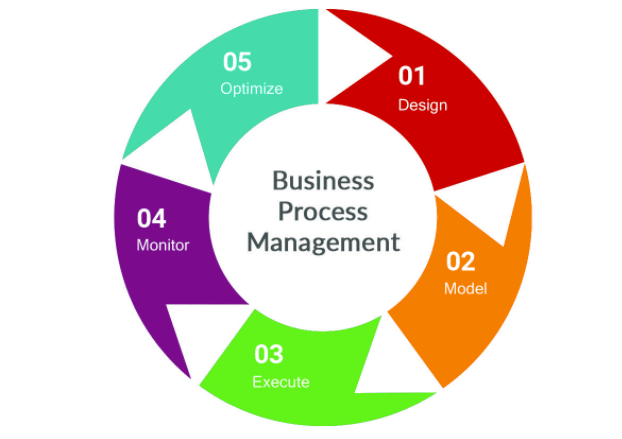
Stage 1: Analyzing
The analysis stage is an important pre-step (before the five key stages commence) to identify inefficiencies and areas for improvement in its current processes.
Business analysts can use qualitative and quantitative approaches to gather this data. These may include value-added analysis to measure each process’s contribution to the business or cause-and-effect modeling to identify efficiencies. Compiling data on every performance metric provides a strong indication of those processes that are the least efficient.
Stage 2: Designing/Modeling
During this next stage, the current process — or “as-is” state — should be drawn out, and the ideal future process management model — or “to-be” state — designed. This includes creating process maps and flowcharts of current (as-is) and future (to-be) processes to visualize workflows and changes.
Once you’ve documented these steps, you can add additional information, such as the time and duration of tasks, where they occur, who is involved, and how information flows through the process.
After the process is fully mapped, end-users should review it to ensure its accuracy and check that improvements proposed in the “to-be” state are likely to deliver value.
Stage 3: Implementing
At the implementation — or execution — stage, the “to-be” state is adopted into the business.
This may require the addition of technology, procedural updates, or changes to resourcing to ensure all stakeholders are trained and equipped. Before implementing the new process to everyone, perform a proof of concept and test it on a small group first to iron out any teething problems.
Stage 4: Monitoring
During the monitoring stage, you track performance metrics to assess the effectiveness of the new processes and check on the expected improvements.
This involves collecting data on key performance indicators (KPIs) to assess how well the process is functioning. Comparing relevant “to-be” metrics with baseline “as-is” data should determine if there is a worthwhile return on its investment. Performance data can also inform decisions on what steps to take next regarding workflow management.
Stage 5: Optimizing
At this stage, you’ll continually refine the process based on feedback and performance data gathered during the monitoring stage as the business changes over time.
Sometimes — as the business grows or its external environment changes significantly — processes become sub-optimal or overly complex, contributing to inefficiency. In such cases, this may involve re-engineering workflows or adopting new technologies to support the changes. This is known as process re-engineering.
What are the 3 types of business process management?
There are three main types of business process management (BPM). Each addresses specific organizational needs—whether integrating systems for efficiency, facilitating human interactions in workflows, or managing critical documents effectively. Understanding these distinctions helps you choose the right BPM approach to optimize your organization’s processes effectively.
Integration-centric BPM
Integration-centric BPM focuses on processes that flow across various enterprise systems, such as Enterprise Resource Planning (ERP) and Customer Relationship Management (CRM) systems, with minimal human intervention. It’s Ideal for organizations looking to automate repetitive tasks, integrate data seamlessly, and improve cross-departmental communication with smooth workflows. Key characteristics include:
- Utilization of APIs and connectors to link core business applications.
- Streamlined processes that enhance data flow and reduce manual errors.
Human-centric BPM
Human-centric BPM deals with processes that require significant human interaction and decision-making. It focuses on workflows that depend on approvals, task assignments, and collaboration among team members, like hiring, project management, and customer service where human input is crucial. Key features include:
- Intuitive user interfaces that facilitate task management.
- Real-time tracking and notifications to keep teams informed about their responsibilities.
Document-centric BPM
Document-centric BPM revolves around managing documents within business processes. It’s particularly relevant in legal, finance, or healthcare industries, where efficient document handling is critical. Key aspects include:
- Streamlining the flow of documents through various stages, including creation, review, approval, and storage.
- Enhancing team collaboration by ensuring all necessary documents are easily accessible and properly managed.
15 strategies to optimize your process management
Process management offers a traditional methodology to embed and improve your business processes. But it’s more than just optimizing a single workflow.
A mature process management strategy requires understanding how process optimization contributes to business goals and how changing one workflow impacts wider operations.
Here are 15 effective strategies to optimize your process management:
Utilize process improvement methodologies
Incorporate Lean, Six Sigma, or Agile methodologies into your process management strategy. These frameworks provide structured approaches for identifying waste, improving quality, and enhancing responsiveness within processes.
Focus on one process at a time
Concentrating on a single process allows for a more thorough analysis and optimization. This focused approach helps identify specific inefficiencies and implement targeted improvements without overwhelming resources or creating confusion across multiple processes.
Value performance over perfection
Where possible, focus on improving existing processes rather than building new ones. The point of process improvement is to drive performance gains, rather than achieving “perfection”. Sometimes, the delay in creating a radical new process can reduce its potential value compared to making more minor changes to an existing process.
Align processes with business strategy
Ensure that each process supports the overall business strategy. Understanding how a process contributes to strategic goals helps prioritize optimization efforts and ensures that improvements align with organizational objectives.
Define success metrics
Establish clear metrics to measure the success of the optimized process. This could include key performance indicators (KPIs) such as cycle time, error rates, or customer satisfaction scores. Defining these metrics upfront allows for better tracking of improvements and outcomes.
Create process maps
Develop detailed process maps for both current (as-is) and improved (to-be) versions of the process. Visualizing workflows helps identify bottlenecks, redundancies, and areas for improvement, making it easier to communicate changes to stakeholders.
Optimize before automating
It’s tempting to think of automation as the fast track to improving your processes. But without taking the time to review and improve processes, automation makes the same (imperfect) process run faster, which could actually make things worse for your business. So, optimize first, automate later.
Automate repetitive tasks
Once optimized, identify process tasks you can automate to reduce manual effort and minimize errors. Automation tools can streamline workflows, enhance accuracy, and allow employees to focus on higher-value activities.
Assess impacting systems and tools
Evaluate all applications, systems, and personnel involved in the process. Understanding how these elements interact can reveal opportunities for integration or improvement that enhance overall efficiency.
Implement low-code solutions
Utilize low-code platforms that allow for quick development and modification of processes without extensive programming knowledge. These tools enable rapid iteration and adaptation of workflows in response to changing business needs.
Get startedStandardize repeated processes
Standardizing repeated processes — such as procurement or recruitment — reduces the likelihood of error and mitigates risk. It also makes it easier for cross-functional teams to be productive and simplifies employee onboarding, even when they move between internal roles.
Encourage collaboration
Foster a culture of collaboration among team members involved in the process. Utilize collaboration tools that integrate with existing systems to improve communication, share insights, and ensure accountability across teams.
Assign ownership
Assigning ownership means there’s someone responsible for embedding the new process in the business and remaining committed to the process design. Having a process owner also means someone familiar with the end-to-end process can continuously assess the need for further improvements.
Conduct regular reviews
Establish a routine for reviewing processes to assess performance against defined metrics. Regular evaluations help identify new areas for improvement as business needs evolve and technologies change.
Build a culture of continuous improvement
Creating a culture of continuous improvement within the organization can be highly beneficial, as you can source valuable ideas from employees closest to the processes involved. Organizations can add creative thinking and problem-solving as desirable skills to job descriptions within the recruitment process. There should also be visible and accessible feedback mechanisms that reward innovation and process improvement ideas.
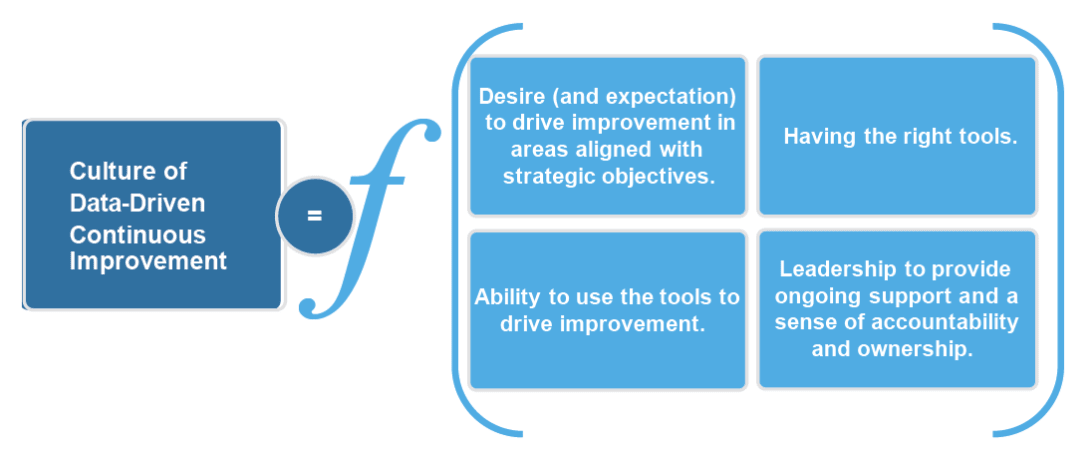
When embarking on process management, you need the right resources and tools. Below, we cover what you need to be successful.
Tools to support effective process management
While organizations can manually complete process management, using business process management software is far more effective. These tools facilitate:
- Process mapping: Visual representation of workflows to identify bottlenecks.
- Automation: Streamlining repetitive tasks through automated systems.
- Analytics: Providing insights into process performance for informed decision-making
Built on top of monday.com Work OS, monday work management helps organizations streamline crucial business processes. Using powerful building blocks such as automations and dashboards, teams and departments can quickly build any workflow for any work process.
Lifecycle management
A core feature of business process management tools is managing the modeling, implementation, and monitoring of processes. With monday work management, you can get started quickly with the ready-to-use process management templates, like this recruitment process template:
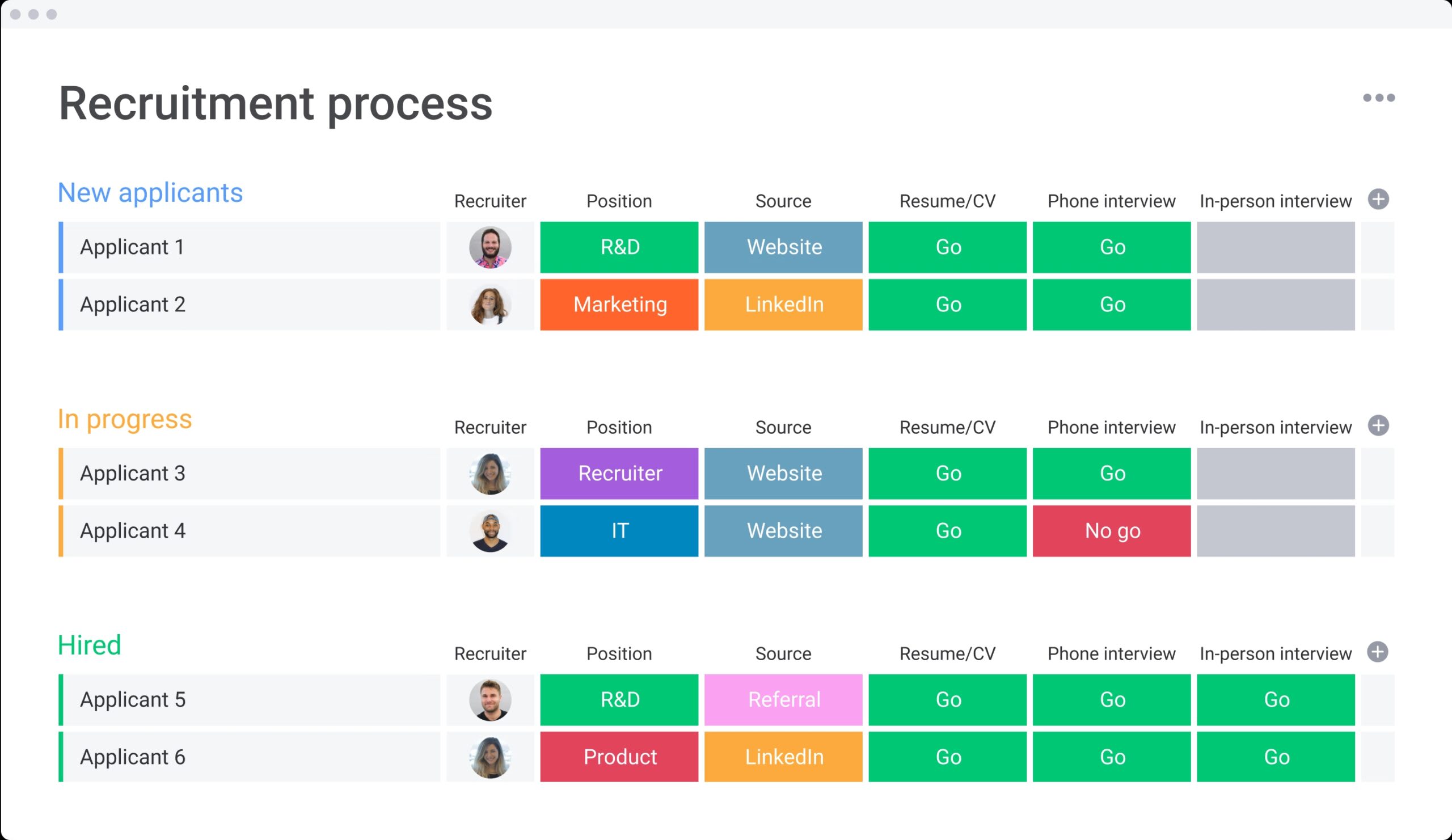
And — like everything on the monday.com platform — they’re fully customizable, so you can design, model, implement, and monitor your processes in a way that makes sense for your business.
Here at monday.com, using our optimized recruitment process — with a built-in applicant tracking system and automations — resulted in:
- 17% improved hire time
- 22% improved candidate experience score
- 29% more candidates processed
Since using the optimized process, our Talent Acquisition Partner Sofia Fleitas said:
Our collaboration with leadership is much more productive, and the relationship between hiring and our company’s performance is clear and visible.
Learn more about the success story in this video.
Analytics and reporting
Choosing a platform with data analytics and reporting is critical.
Reviewing and analyzing process performance can trigger process improvement, so your software solution must have that capability. Plus, once you’ve implemented the “to-be” state, monitoring the metrics you care about helps you understand how effective the new process is and what you should focus on next.
With monday work management, you get a full suite of analytics plus 27+ different ways to view your data, so you have the information you need throughout the process management lifecycle.
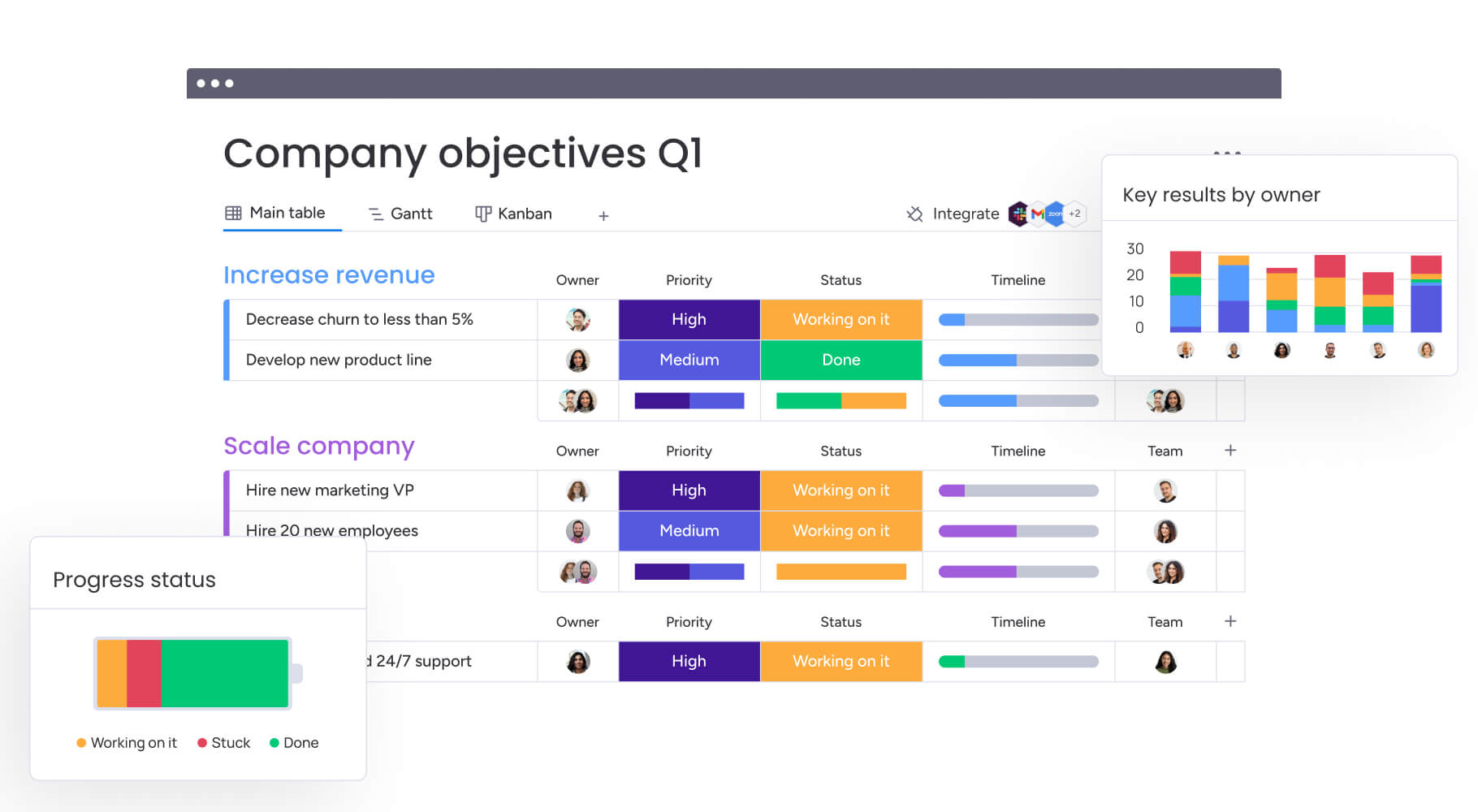
Collaboration
Effectively mapping current processes and designing the future state requires the input of multiple stakeholders.
Business analysts are responsible for process mapping, but they’ll need the expertise of end-users to inform the work and the input of other stakeholders impacted by process change. Plus, implementing a new process requires change and may need people to work together differently to make the new process a success.
With monday work management, stakeholders can create, share, review, and annotate documents, operational plans, and workflows. They can also collaborate in-platform, which means communication happens in context.
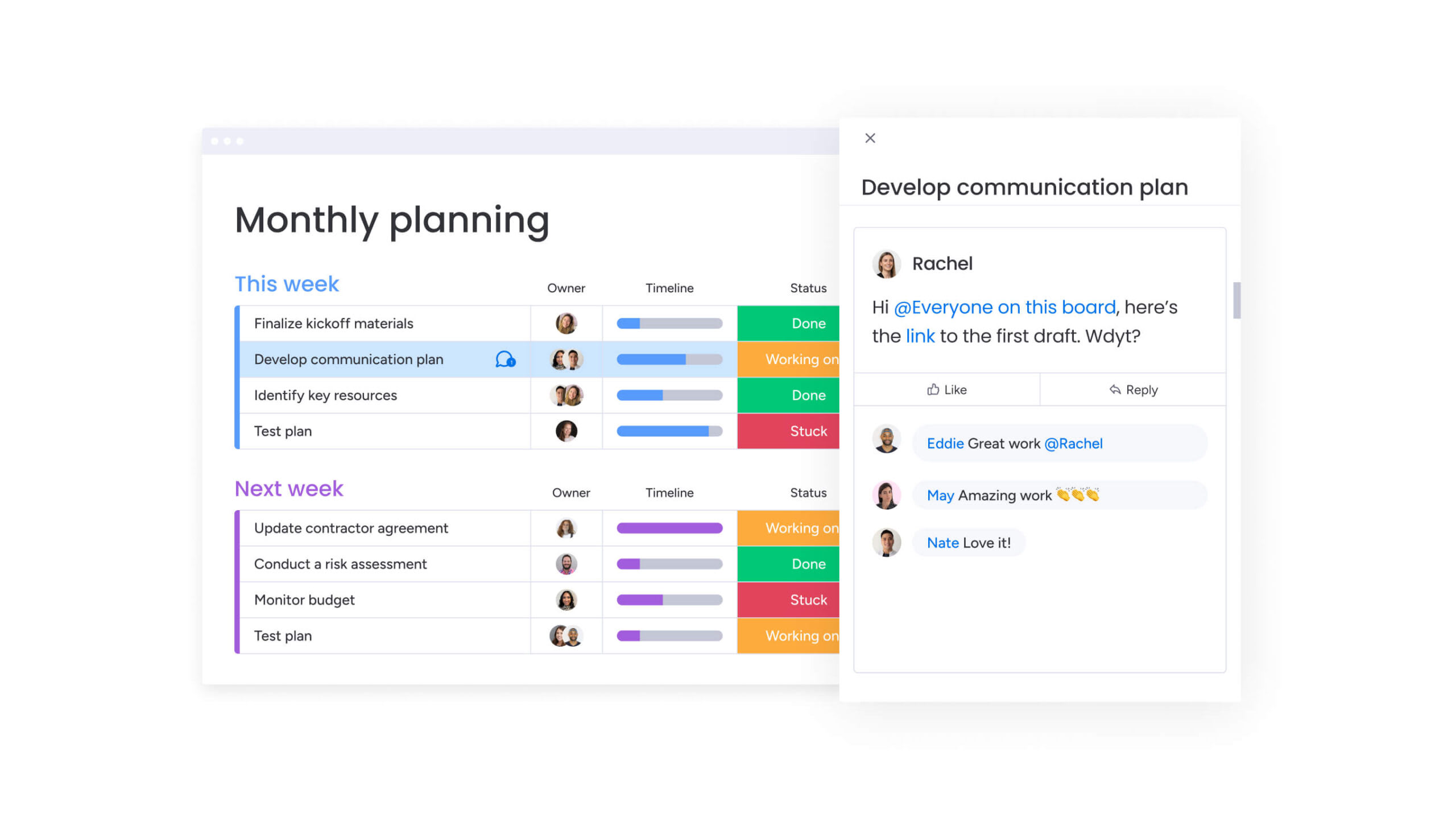
It also integrates with over 200 other apps, so if you already have a collaboration app that works for your team, monday work management can slot right in alongside it.
Automation
For mature, optimized processes, automating repetitive, manual tasks can create additional value and reduce the likelihood of human error.
Enabling employees to focus on more purposeful work has the side benefit of increasing employee engagement. This is helpful as employees who are invested in a business’s success find it easier to adapt to changes that drive business benefits.
With monday work management, it’s easy to automate tasks to boost team efficiency and engagement. Any event within the platform — such as a change in task status — can trigger an action. Automations can remind you of deadlines, notify someone of a change, or add new tasks to a workflow.
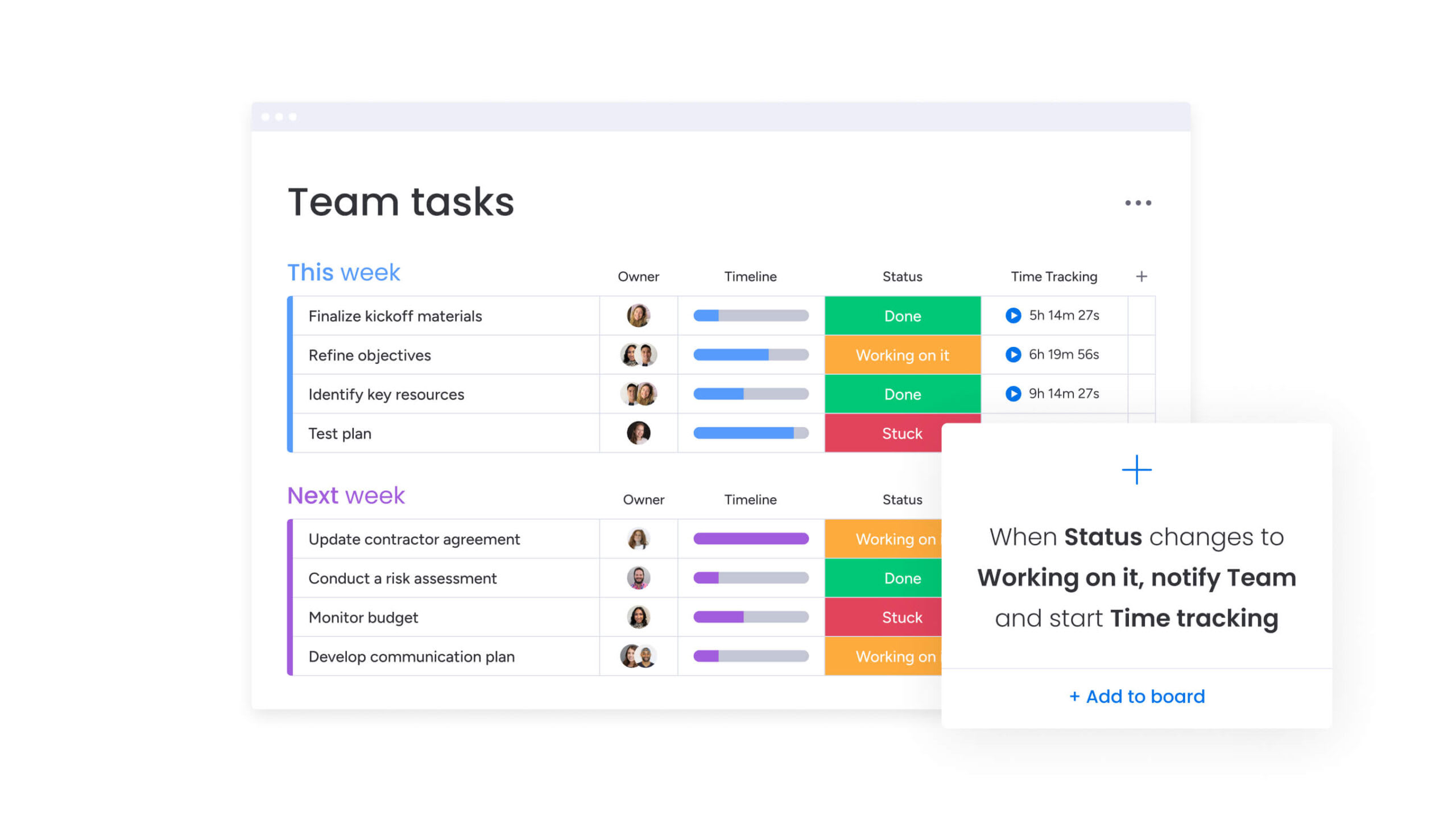
Master your process management with monday.com
With monday work management, you have the tools to implement robust process management practices that align with your strategic business goals. You can streamline crucial business processes, set goals and strategies, and optimize projects and everyday work.
Ready to revamp your business processes, eliminate operational inefficiencies, reduce costs, and ensure employee and customer satisfaction? Take a free 14-day trial of monday work management today.
Get startedFAQs
What does process management consist of?
Process management consists of designing, implementing, monitoring, and optimizing business processes to improve efficiency and achieve organizational goals. It typically involves mapping workflows, establishing performance metrics, analyzing bottlenecks, implementing improvements, and continuously refining processes. The key components include analysis, process design and modeling, execution, monitoring, and optimization to ensure processes remain aligned with business objectives.
What does a process management specialist do?
A process management specialist is responsible for analyzing, designing, implementing, and optimizing business processes to improve organizational efficiency and productivity. They typically work on identifying bottlenecks, streamlining workflows, and implementing process improvements across various departments. Their role involves collaborating with different teams, using process mapping and analysis tools, and ensuring that processes align with the company's strategic goals and objectives.
What is good process management?
Effective process management involves systematically designing, implementing, and optimizing business processes to enhance efficiency and achieve strategic goals. It requires a thorough understanding of workflows to identify areas for improvement, fostering transparency, accountability, and collaboration across the organization. By ensuring that processes are streamlined and aligned with business objectives, optimal process management leads to improved productivity, reduced costs, and greater customer satisfaction.
Don’t miss more quality content!
